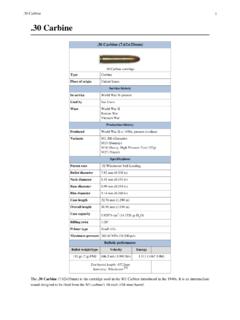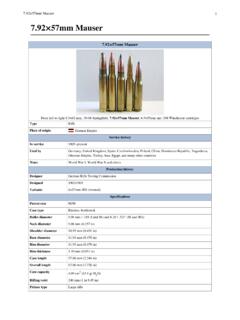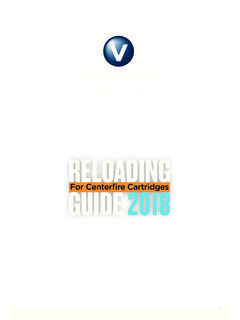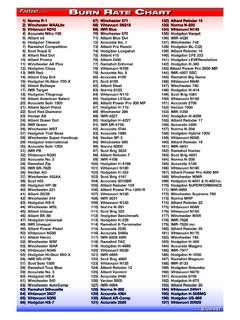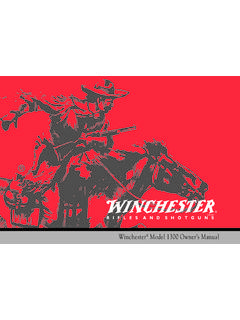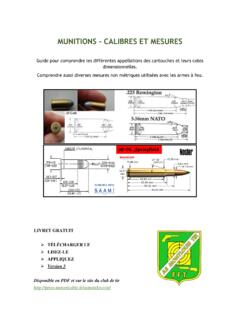Transcription of 7.62×51mm NATO
1 51mm 51mm 51mm 51mm NATO rounds compared to AA (LR6) of origin United StatesService historyIn service1954 presentUsed byUnited States, NATO, War, Falklands Conflict, The Troubles, Gulf War, War in Afghanistan, Iraq War,Libyan civil war, among other conflictsSpecificationsParent winchester (derived from the .300 Savage)Case typeRimless, BottleneckBullet mm ( in)Neck mm ( in)Shoulder mm ( in)Base mm ( in)Rim mm ( in)Rim mm ( in)Case mm ( in)Overall mm ( in)Rifling twist1:12"Primer typeLarge RifleMaximum pressure415 MPa (60,200 psi)Ballistic performanceBullet g (147 gr) M80 m/s (2,733 ft/s)3,304 J (2,437 ft lbf) g (175 gr) M118 LongRange m/s (2,580 ft/s)3,506 J (2,586 ft lbf)Test barrel length: 24"Source(s): M80: Slickguns,[1] M118 Long Range: US Armorment[2] 51mm NATO2 The 51mm NATO (official NATO nomenclature NATO) is a rifle cartridge developed in the 1950s as astandard for small arms among NATO countries.
2 It should not to be confused with the similarly named 54mmR was introduced in service in the M14 rifle and M60 machine gun in the late 1950s. The M14 was supersededin service as the infantry adopted the 45mm NATO M16. However, the M14 and many other firearms thatuse the 51 round remain in service, especially in the case of sniper rifles, machine guns, and as the serviceweapon chosen by special operations forces. The cartridge is used both by infantry and on mounted and crew-servedweapons mounted to vehicles, aircraft and not identical, the 51mm NATO and the commercial .308 winchester cartridges are similar, and eventhough the Sporting Arms and Ammunition Manufacturers' Institute (SAAMI) considers it safe (by not listing it) tofire the NATO round in weapons chambered for the commercial round, there is significant discussion[3][4][5] aboutcompatible chamber and muzzle pressures between the two cartridges based on powder loads and wall thicknesseson the military vs.
3 Commercial rounds. The debate goes both ways, the ATF recommends checking the stamping onthe barrel; if you're unsure, consult the maker of the firearm.[6][7]OverviewThe cartridge itself offers similar ballistic performance in most firearms to the .30-06 Springfield that it replaced service. Though shorter, standard loadings fire similar bullet weights with only a slight reduction in propellants allowed for similar performance from a case with less capacity. The smaller case requires lessbrass and yields a shorter cartridge. This shorter cartridge allows a slight reduction in the size and weight of firearmsthat chamber it, and somewhat better cycling in automatic and semi-automatic comparison between the 51mm NATO, .30-06 Springfield, and .300 winchester magnum for common bullet that would eventually developthe 51mm NATO started justafter World War I when the large,powerful.
4 30-06 cartridge proveddifficult to adapt to semi-automaticrifles. A less-powerful cartridge wouldallow a lighter firing mechanism. Atthe time the most promising designwas the .276 Pedersen. When it waseventually demonstrated that was suitable for semi-automaticrifles, the .276 was when war appeared to belooming again only a few decadeslater, the .30-06 was the only roundavailable and the M1 Garand providedUS troops with greater firepower thantheir bolt action-armed opponents. TheGarand performed so well that the US saw little need to replace it during World War II and the .30-06 served wellbeyond the Korean War and into the mid the 1940s and early 1950s several experiments were carried out to improve the Garand. One of the most common complaints was the limited capacity 8-round en-bloc clip and many experimental designs modified 51mm NATO3weapon with a detachable box magazine.
5 Springfield Armory's T20 rifle was a fully automatic version. Though notadopted, experience with a fully automatic Garand laid the groundwork for its BMG, .300 winchester magnum , .308 WIN( NATO), 39mm, NATO, and . recovered 51mm NATO bullets (nextto an unfired cartridge (Tracer ammunition),showing rifling marksThe test program continued for several years, including both theoriginal .30-06 round and a modified .300 Savage (then known as theT65). In the end, the T65 cartridge demonstrated power roughly equalto the original .30-06, firing a 147-grain bullet at 2,750 feet per second(840 m/s) but was approximately half an inch shorter. The eventualresult of this competition was the T44 the United States developed the T65 cartridge, the Britishmilitary took a different route. They had spent considerable time andeffort developing the intermediate-power .280 British (7 mm) cartridgewith an eye towards controllable fully automatic fire.)
6 The US held toits desire not to reduce the effectiveness of individual aimed shots. TheAmerican philosophy was to use automatic fire for emergencies onlyand continue to use semi-automatic fire the majority of the time. Afterconsiderable debate, the Canadian Army announced they would behappy to use the .280 but only if the did as well. It was clear was not going to use the .280. The British did start introducing along with the "bull-pup" Rifle No. 9, but the process was stoppedin the interests of harmonization across NATO. The T65 was chosen asthe NATO standard cartridge in T44 was adopted as the M14 in 1957. Britain and Canada adoptedthe Belgian FN FAL around the same time followed by West Germanarmy as the G1. The Germans soon transitioned to a modified versionof the Spanish CETME rifle, Heckler & Koch G3. With all three ofthese firearms, it was clear that the NATO could not be firedcontrollably in fully automatic because of recoil.
7 Both the M14s andFAL would later go through several variations intended to either limitfully automatic selection through semi-auto version or selector locks orto improve control with bipods or heavier this was going on, the Project SALVO concluded that aburst of four rounds into a 20-inch (510 mm) circle would cause twicethe number of casualties as a fully automatic burst by one of theserifles, regardless of the size of the round. They suggested using a muchsmaller .22 caliber cartridge with two bullets per cartridge (a duplex load), while other researchers investigated thepromising flechette rounds that were lighter but offered better penetration than even the .30-06. These studies werekept secret to prevent the British from using them as evidence in favour of their smaller the M14 arrived in Vietnam, it was found to have a few disadvantages. The rifle's overall length was not wellsuited for jungle warfare.
8 Also, the weight of 51mm cartridges limited the total amount of ammunition thatcould be carried in comparison with 51mm NATO4 Comparison of mm NATO, mm NATOand 9 mm 39mm cartridge of the Type 56 and AK-47 assault rifles, whichthe Vietcong and North Vietnamese Army soldiers were equippedwith. In addition, the originally issued wooden stocked versions of theM14 were susceptible to warping from moisture in tropicalenvironments, producing "wandering zeroes" and other accuracyproblems, which caused the adoption of fiberglass between the big-round and small-round groups reached a peakin the early 1960s, when test after test showed the .223 Remingtoncartridge fired from the AR-15 allowed an 8-soldier unit to outgun an11-soldier unit armed with M14s.
9 Troops were able to carry morethan twice as much 45mm ammunition as 51mm for thesame weight, which allowed them an advantage against a typical NVAunit armed with Type weightWeight of loaded magazine10 kilogram ammo 51mm393 gr ( )20 rds @ .68 kg14 mags / 280 45mm183 gr ( )20 rds @ .3 kg33 mags / 660 39mm281 gr ( )30 rds @ kg*[8]8 mags / 240 rds(*AK-47 magazines are much heavier than M14 and M16 magazines)In 1964, the Army started replacing their M14s with the M16, incurring another series of complaints from theBritish. Regardless of the M14 having disadvantages in jungle warfare, 51mm NATO rifles stayed in militaryservice around the world due to several factors. The 51mm NATO has proved much more effective 45mm at long ranges, and has since found popularity as a sniping round. For instance, M14 variants such as theMk 14 Enhanced Battle Rifle and M25 are still used in the United States military as designated marksman and sniperrifles.
10 Shorter, easier to handle rifles like the Heckler & Koch G3 stayed in service due to their accuracy,range, cartridge effectiveness and 51mm NATO and 45mm NATO cartridges compared to an AA 51mm NATO round nevertheless met the designer'sdemands for fully automatic reliability with a full-power round. Itremained the main machine gun round for almost all NATO forceswell into the 1990s, even being used in adapted versions of machine guns such as the Browning M1919A4 from the WWIIera. These have been replaced to a considerable extent in the lightmachine gun role by 45mm NATO weapons, such as thewidespread use of the M249 SAW, but the round is still thestandard chambering for most general-purpose machine guns such asthe M60E4, the M240 and the German HK21 and MG3, and flexiblemountings such as helicopters, jeeps, and Ammunition (a division of the Olin Corporation) saw themarket for a civilian model of the T65 cartridge and released itcommercially in 1952 as the.
